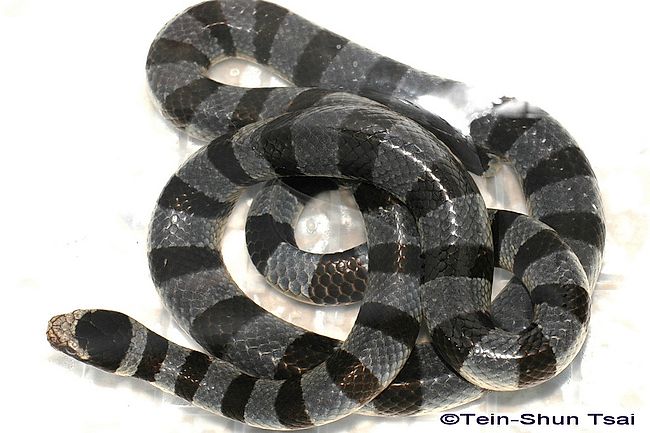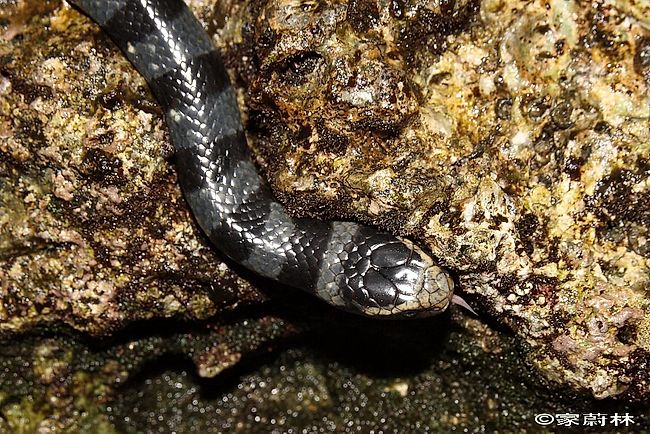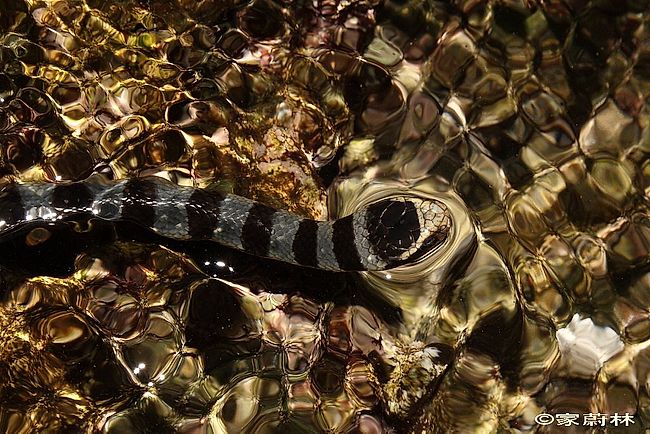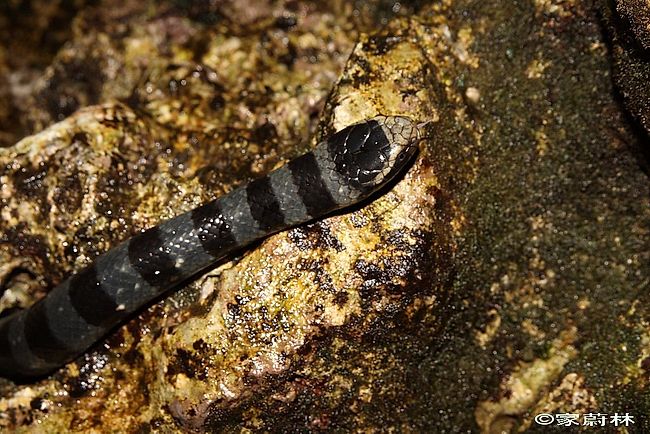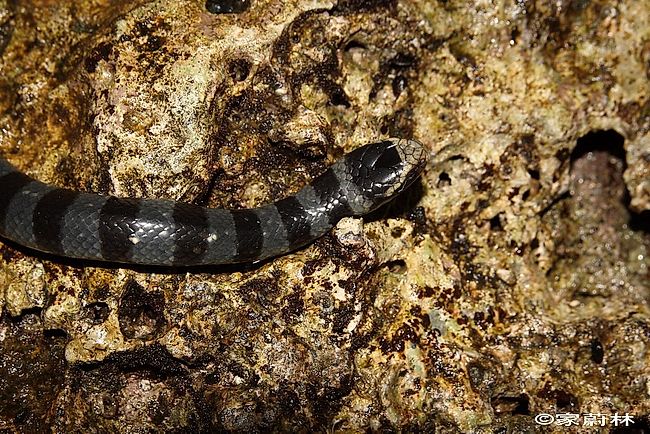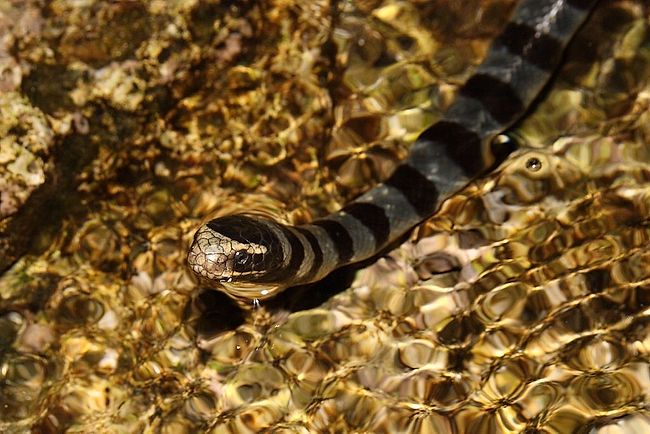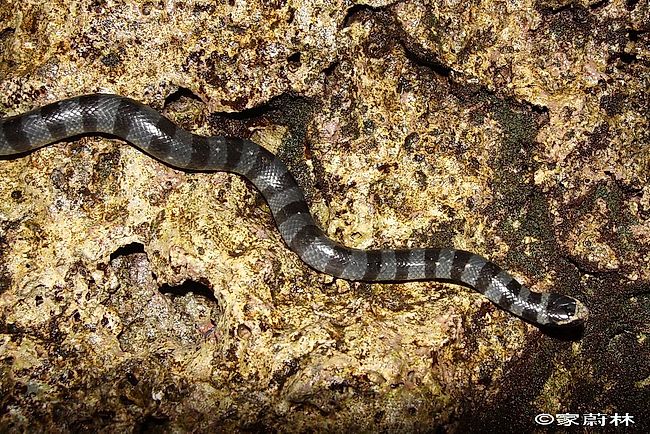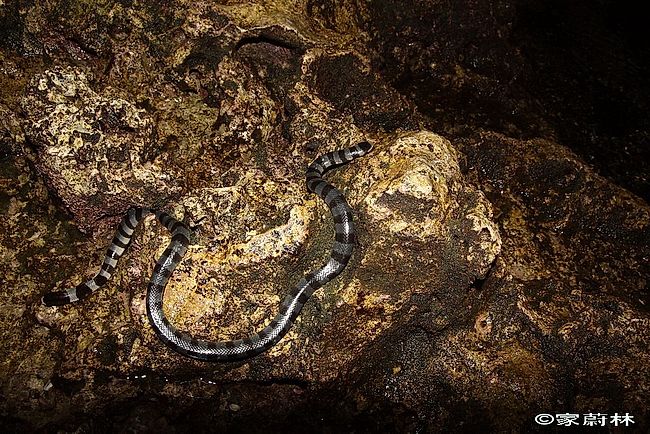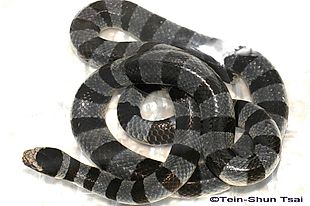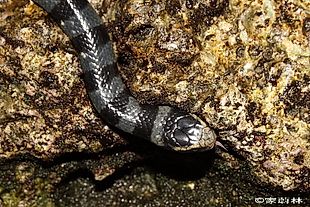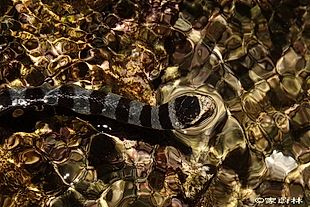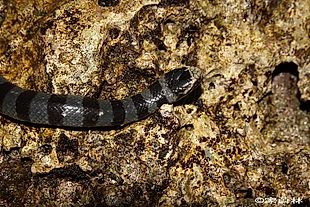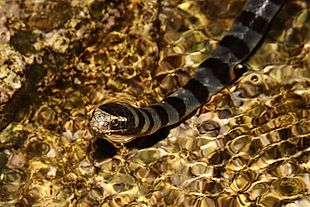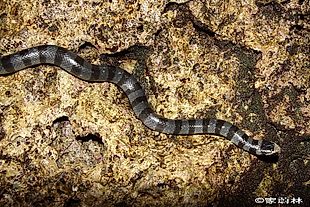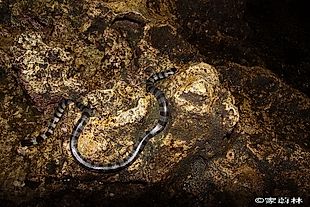Laticauda colubrina
Yellow-lipped Sea Krait
黃 唇青斑海蛇 (huang2chun2qing1ban1hai3she2)
Status: Not protected
HIGHLY VENOMOUS!
Family
Elapidae, subfamily Hydrophiidae
Max. length
170 cm
Occurrence in Taiwan
Along the coast of eastern Taiwan, especially in Orchid Island, occasionally in Kenting.
Global Distribution
Indian Ocean (East India, Sri Lanka, Myanmar, Malaysia, Indonesia, Melanesia, Polynesia), Solomon Islands, Gulf of Thailand, Philippines, Andaman Islands, Nicobar Islands, Taiwan, China, Bay of Bengal, Peninsular Malaysia, Indoaustralian Archipelago to New Guinea, Japan (Ryukyu Islands), Australia (New South Wales, Queensland), New Zealand, Western Pacific Ocean to Fiji, New Caledonia, Mexico, El Salvador, Nicaragua
Description
Medium to large snake; total length up to 170 cm. There are 21-25 (23-25 at mid-body) rows of smooth and glossy scales. Head is broad, flattened on top, very slightly triangular, but not distinct from neck; body is moderately stout and slightly compressed laterally, especially in posterior quarter; tail is laterally compressed, sides with vertically elongated scales. The ventrals are medium size, which is one-third to more than half the width of body. Eye is medium-sized; iris is gray to blue gray, flecked with black and pupil is round and black. Tongue is flesh-colored, darkened by scatttered black pigment, outer half of fork tips dirty white. Fangs are medium size, rigid, in anterior part of upper jaw. There are 3 prefrontals (i.e., a large azygous shield between the prefrontals) and no loreals; the rostral is entire. Upper head is distinctly marked; snout and the lower half of supralabials is yellow to grey, and the remainder of the head is black except for a bar of yellow extending back above eye to temporal region. Upper body and tail are gray to blue gray while the ventral body is dirty white to cream, which are encircled completely by black, prominent bands with clearly defined borders; the black bands are narrower than the interspaces. Ventral head has prominent broad longitudinal stripe of black from mouth, extending posteriorly to join first two bands of body; chin and gular shields are dirty white to yellow. Anal scale is divided and subcaudals are paired.
Biology & Ecology
"L. colubrina are truly marine but have a terrestrial mode of reproduction. They inhabit shallow tropical seas surrounding small coral islands, coral reefs and mangroves, usually with a sand or coral substrate. They are found at depths ranging between 1-10m. The reason for this is mainly because of the low permeability of the skin, which could be dangerous below these depths. L. colubrina are mostly nocturnal and primarily move between land and ocean during this time but have also been found foraging during the day. They move over large areas of the reef in search for food. Despite being a marine species, they seem to prefer freshwater to seawater and have been seen drinking rainwater from puddles on the ground and from depressions in leaves. They shed their skin either on land or in the sea
Their main prey item is eel but they have also been observed feeding on small fish such as gobies. They trap their prey in coral crevices using coils of their body. L. colubrina show sex-based ecological divergence. For example, males being the smaller sex usually forage in shallower water than females and also tend to prey on different kinds of eels, than do their mates. Males take smaller, reef-flat eels whereas females prey on larger eels in waters close to the reef.
The reproductive biology of L. colubrina and other species of the family Laticaudinae are different from all other sea snakes. They are oviparous and need to come ashore on small isolated islands to lay their eggs. Large aggregations form at these breeding and resting sites. L. colubrina undertake long distance migrations for breeding. Males reach sexual maturity at about 18 months whereas females can take up to 24 months before they are ready to breed. Clutch sizes tend to be large but may vary geographically, with smaller clutch sizes in some areas and larger in others. A female can lay 4-20 eggs at any time of the year. The populations of L. colubrina have smaller numbers of juveniles than adults, which is most likely a result of low fecundity and high juvenile mortality." (Source)
Laticauda colubrina are the world's most venomous snakes. However, due to their inoffensive, docile nature they seldom bite, even in self defense.
They are often seen in large numbers in the company of hunting parties of Giant trevally (Caranx ignobilis) and Goatfish.
L. colubrina use skin markings and behavior patterns to fool predators into thinking their tail is a second head, complete with lethal venom:
"In a deadly game of heads or tails venomous sea snakes in the Pacific and Indian Oceans deceive their predators into believing they have two heads, claims research published August 5., 2009, in Marine Ecology....The reason for this mixture of behaviour and coloration results from a developed defence strategy needed when the snake is probing for prey. Despite being extremely venomous, sea snakes are susceptible to attacks from several predators such as sharks, large bony fishes, and even birds." More on this study in this Science Daily article.
Etymology
Laticauda = from the Latin latus = broad, and cauda, tail, in reference to the wide, flat tail;
colubrina = from the Latin colubrinus = having the qualities of a snake.
The Chinese name 黃唇青斑海蛇 (huang2chun2qing1ban1hai3she2) means "Yellow-Lipped (黃唇) White-Striped (青斑) Sea Snake (海蛇)".
Further Info








